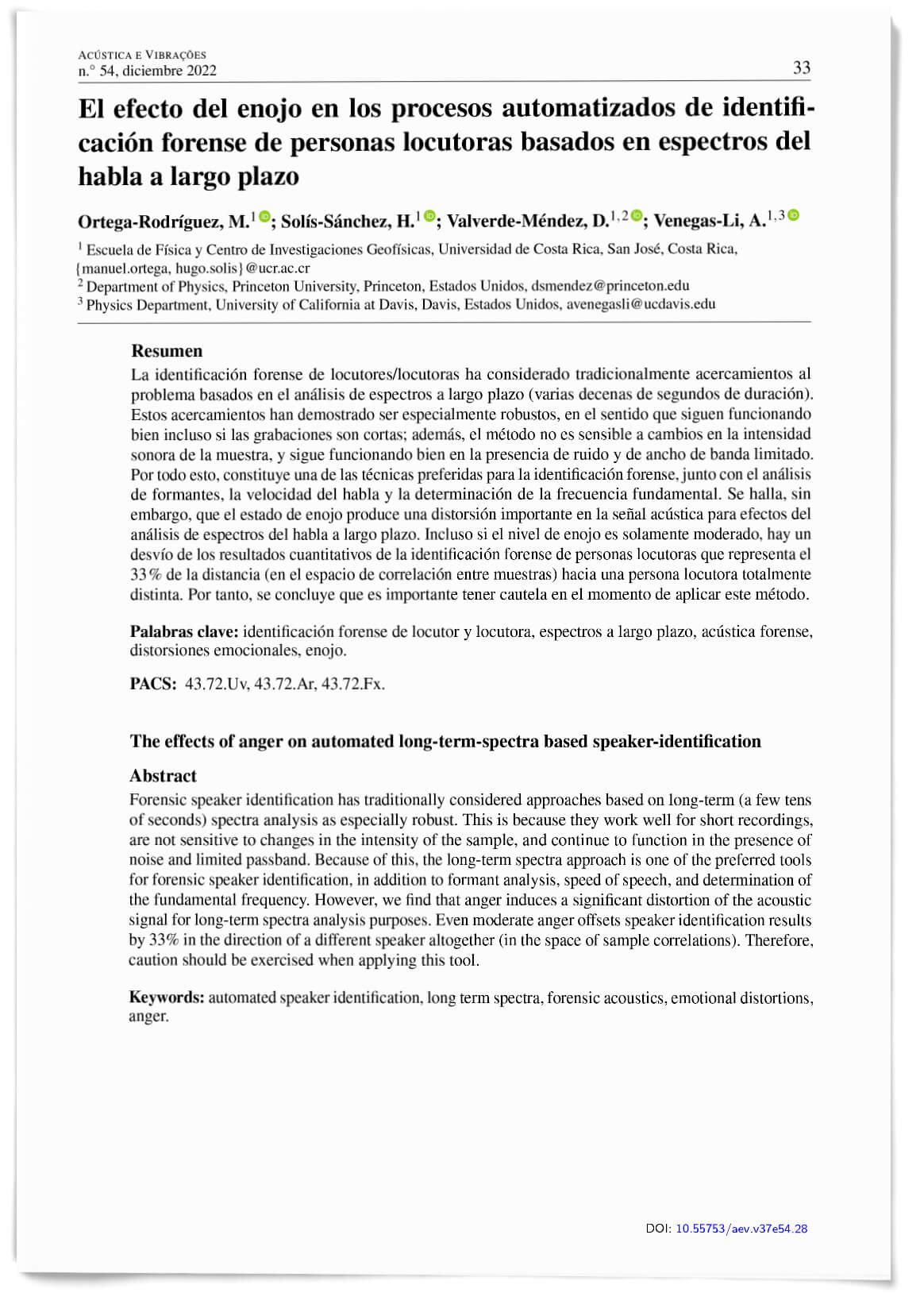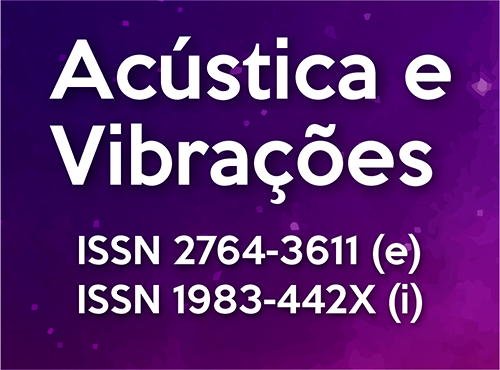El efecto del enojo en los procesos automatizados de identificación forense de personas locutoras basados en espectros del habla a largo plazo
DOI:
https://doi.org/10.55753/aev.v37e54.28Palabras clave:
Identificación forense de locutor y locutora, Espectros a largo plazo, Acústica forense, Distorsiones emocionale, EnojoResumen
La identificación forense de locutores/locutoras ha considerado tradicionalmente acercamientos al problema basados en el análisis de espectros a largo plazo (varias decenas de segundos de duración). Estos acercamientos han demostrado ser especialmente robustos, en el sentido que siguen funcionando bien incluso si las grabaciones son cortas; además, el método no es sensible a cambios en la intensidad sonora de la muestra, y sigue funcionando bien en la presencia de ruido y de ancho de banda limitado. Por todo esto, constituye una de las técnicas preferidas para la identificación forense, junto con el análisis de formantes, la velocidad del habla y la determinación de la frecuencia fundamental. Se halla, sin embargo, que el estado de enojo produce una distorsión importante en la señal acústica para efectos del análisis de espectros del habla a largo plazo. Incluso si el nivel de enojo es solamente moderado, hay un desvío de los resultados cuantitativos de la identificación forense de personas locutoras que representa el 33% de la distancia (en el espacio de correlación entre muestras) hacia una persona locutora totalmente distinta. Por tanto, se concluye que es importante tener cautela en el momento de aplicar este método.
Citas
HOLLIEN, Harry. Barriers to Progress in Speaker Identification with Comments on the Trayvon Martin Case. Linguistic Evidence in Security, Law and Intelligence, University Library System, University of Pittsburgh, v. 1, n. 1, p. 76–98, dic. 2013. ISSN 2327-5596. doi: 10.5195/lesli.2013.3. DOI: https://doi.org/10.5195/LESLI.2013.3
HOLLIEN, Harry. An Approach to Speaker Identification. Journal of Forensic Sciences, Wiley, v. 61, n. 2, p. 334–344, feb. 2016. doi: 10.1111/1556-4029.13034, pMID: 27404606. DOI: https://doi.org/10.1111/1556-4029.13034
HOLLIEN, Harry Francis. Forensic Voice Identification. Londres, Inglaterra: Academic Press, 2002. ISBN 0123526213.
WILLIAMS, Carl E.; STEVENS, Kenneth N. Emotions and speech: Some acoustical correlates. The Journal of the Acoustical Society of America, Acoustical Society of America (ASA), v. 52, n. 4B, p. 1238–1250, oct. 1972. doi: DOI: https://doi.org/10.1121/1.1913238
BANSE, Rainer; SCHERER, Klaus R. Acoustic profiles in vocal emotion expression. Journal of Personality and Social Psychology, American Psychological Association (APA), v. 70, n. 3, p. 614–636, 1996. doi: 10.1037/0022- DOI: https://doi.org/10.1037//0022-3514.70.3.614
JOHNSTONE, Tom. The effect of emotion on voice production and speech acoustics. Tesis (PhD) — University of Western Australia & University of Geneva, Perth, Australia, 2001. doi: https://doi.org/10.31237/osf.io/qd6hz. DOI: https://doi.org/10.31237/osf.io/qd6hz
SCHERER, Klaus R. Voice, Stress, and Emotion. In: . Dynamics of Stress: Physiological, Psychological and Social Perspectives. 1. ed. [S.l.]: Springer US, 1986. p. 157–179. ISBN 978-1-4684-5122-1. doi: 10.1007/978-1-4684- 5122-1_9.
n.◦ 54, diciembre 2022
MARTIN, Maryanne. On the induction of mood. Clinical Psychology Review, Elsevier BV, v. 10, n. 6, p. 669–697, ene. 1990. ISSN 1873-7811. doi: 10.1016/0272-7358(90)90075-l. DOI: https://doi.org/10.1016/0272-7358(90)90075-L
HOLLIEN, Harry; MAJEWSKI, Wojciech. Speaker identification by long-term spectra under normal and distorted speech conditions. The Journal of the Acoustical Society of America, Acoustical Society of America (ASA), v. 62, n. 4, p. 975–980, oct. 1977. ISSN 1520-8524. doi: 10.1121/1.381592. DOI: https://doi.org/10.1121/1.381592
KINNUNEN, Tomi; HAUTAMAKI, Ville; FRANTI, Pasi. On the Use of Long-Term Average Spectrum in Automatic Speaker Recognition. In: Proc. International Symposium on Chinese Spoken Language Processing. [s.n.], 2006. p. 559–567. Disponible en: https://citeseerx.ist.psu.edu/document?repid=rep1&type=pdf&doi=d3b4740466aeb1d25831b6329599b615a5bab9b1.
ORTEGA-RODRIGUEZ, Manuel. Informe Final: Articulación de un sistema de identificación de locutor con fines forenses. [S.l.], 2016. Accedida en noviembre de 2021. Disponible en: https://hdl.handle.net/10669/85190.
HARMEGNIES, Bernard. SDDD: A new dissimilarity index for the comparison of speech spectra. Pattern Recognition Letters, Elsevier BV, v. 8, n. 3, p. 153–158, oct. 1988. ISSN 1872-7344. doi: 10.1016/0167-8655(88)90093-1. DOI: https://doi.org/10.1016/0167-8655(88)90093-1
STANTON, Jeffrey M. Galton, Pearson, and the Peas: A Brief History of Linear Regression for Statistics Instructors. Journal of Statistics Education, Informa UK Limited, v. 9, n. 3, ene. 2001. ISSN 1069-1898. doi: 10.1080/10691898.2001.11910537. DOI: https://doi.org/10.1080/10691898.2001.11910537
FULLER, Fred H. Detection of emotional stress by voice analysis final report. Bethesda, Maryland, USA, 1972. Disponible en: https://www.ojp.gov/ncjrs/virtual-library/abstracts/detection-emotional-stress-voice-analysis-final-report.
HARNSBERGER, James D.; HOLLIEN, Harry; MARTIN, Camilo A.; HOLLIEN, Kevin A. Stress and Deception in Speech: Evaluating Layered Voice Analysis. Journal of Forensic Sciences, Wiley, v. 54, n. 3, p. 642–650, mayo 2009. ISSN 1556-4029. doi: 10.1111/j.1556-4029.2009.01026.x. DOI: https://doi.org/10.1111/j.1556-4029.2009.01026.x
PITTAM, Jeffery. The Long-Term Spectral Measurement of Voice Quality as a Social and Personality Marker: A Review. Language and Speech, SAGE Publications, v. 30, n. 1, p. 1–12, ene. 1987. ISSN 1756-6053. doi: 10.1177/002383098703000101. DOI: https://doi.org/10.1177/002383098703000101
RODMAN, Robert D.; POWELL, Michael S. Computer Recognition of Speakers Who Disguise Their Voice. In: The International Conference on Signal Processing Applications and Technology (ICSPAT 2000). [s.n.], 2000. Disponible en: https://api.semanticscholar.org/CorpusID:16980245.
HERTRICH, I.; ZIEGELMAYER, G. Sexual dimorphism in the long term speech spectrum. Human Evolution, Springer Science and Business Media LLC, v. 2, n. 3, p. 255–262, mayo 1987. doi: 10.1007/bf03016110. DOI: https://doi.org/10.1007/BF03016110
LINVILLE, Sue Ellen. Source Characteristics of Aged Voice Assessed from Long-Term Average Spectra. Journal of Voice, Elsevier BV, v. 16, n. 4, p. 472–479, dic. 2002. doi: 10.1016/s0892-1997(02)00122-4. DOI: https://doi.org/10.1016/S0892-1997(02)00122-4
YÜKSEL, Mustafa; GÜNDÜZ, Bülent. Long term average speech spectra of Turkish. Logopedics Phoniatrics Vocology, Informa UK Limited, v. 43, n. 3, p. 101–105, sep. 2017. doi: 10.1080/14015439.2017.1377286. DOI: https://doi.org/10.1080/14015439.2017.1377286
National Institute of Standards and Technology. NIST/SEMATECH e-Handbook of Statistical Methods. [s.n.], 2012. Accedida en octubre de 2021. Disponible en: https://www.itl.nist.gov/div898/handbook/prc/section2/prc222.htm.
Audacity Team. Audacity (versión 2.1.0), editor y grabador de audio. 2015. Disponible en: https://www.audacityteam.org/.
The International Association for Forensic Phonetics and Acoustics. Code of Practice. [S.l.], 2004. Accedida en enero de 2018. Disponible en: https://www.iafpa.net/the-association/code-of-practice/.

Publicado
Cómo citar
Número
Sección
Licencia
Derechos de autor 2022 Acústica e Vibrações

Esta obra está bajo una licencia internacional Creative Commons Atribución-NoComercial-CompartirIgual 4.0.




